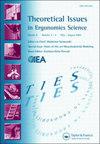Construct validity, internal consistency and test-retest reliability of ergonomic risk assessment for musculoskeletal disorders in office workers (ERAMO)
IF 1.4
Q4 ERGONOMICS
引用次数: 0
Abstract
Abstract Musculoskeletal disorders (MSDs) have a multifactorial etiology, therefore, their assessment should consider all of individual, physical and psychosocial factors. The Ergonomic risk assessment for musculoskeletal disorders in office workers (ERAMO) is a few specific tools available to evaluate the nature and occurrence of MSDs in office workers and the impact of individual and ergonomic aspects of office workers. The purpose of this study was to perform a construct validity (confirmatory factor analysis; CFA) and verify the reliability, internal consistency of the ERAMO in office workers. A sample of 300 workers from two of government enterprise in Bangkok, Thailand participated in this validation and internal consistency analysis. Intraclass correlation coefficient was used for the statistical analysis of test-retest reliability. The calculation of internal consistency, reproducibility provided evidence of reliability and lack of redundancy. The psychometric properties of the ERAMO were assessed using CFA, which revealed 3 models. For 2 models, the comparative fit index (CFI), goodness-of-fit index (GFI), and non-normed fit index (NNFI) each achieved 0.90, the Chi-square and root mean square error of approximation (RMSEA) demonstrated better values. The results provided this ERAMO tool is a choice that can use for ergonomic risk assessment in office workers. Supplemental data for this article is available online at https://doi.org/10.1080/1463922X.2021.1922780 .办公人员肌肉骨骼疾病人体工程学风险评估的结构效度、内部一致性和重测信度
摘要肌肉骨骼障碍(MSDs)具有多因素病因,因此,对其评估应考虑所有的个人、身体和心理社会因素。办公室工作人员肌肉骨骼疾病的工效学风险评估(ERAMO)是评估办公室工作人员MSD的性质和发生情况以及办公室工作人员个人和工效学方面影响的一些特定工具。本研究的目的是进行结构有效性(验证性因素分析;CFA),并验证办公室工作人员ERAMO的可靠性和内部一致性。来自泰国曼谷两家政府企业的300名工人样本参与了验证和内部一致性分析。组内相关系数用于重测信度的统计分析。内部一致性和再现性的计算提供了可靠性和缺乏冗余的证据。使用CFA评估ERAMO的心理测量特性,其中揭示了3个模型。对于2个模型,比较拟合指数(CFI)、拟合优度指数(GFI)和非赋范拟合指数(NNFI)均达到0.90,卡方和均方根近似误差(RMSEA)表现出更好的值。结果表明,该ERAMO工具是一种可用于办公室工作人员人体工程学风险评估的选择。本文的补充数据可在线获取,网址为https://doi.org/10.1080/1463922X.2021.1922780。
本文章由计算机程序翻译,如有差异,请以英文原文为准。
求助全文
约1分钟内获得全文
求助全文

 求助内容:
求助内容: 应助结果提醒方式:
应助结果提醒方式:


